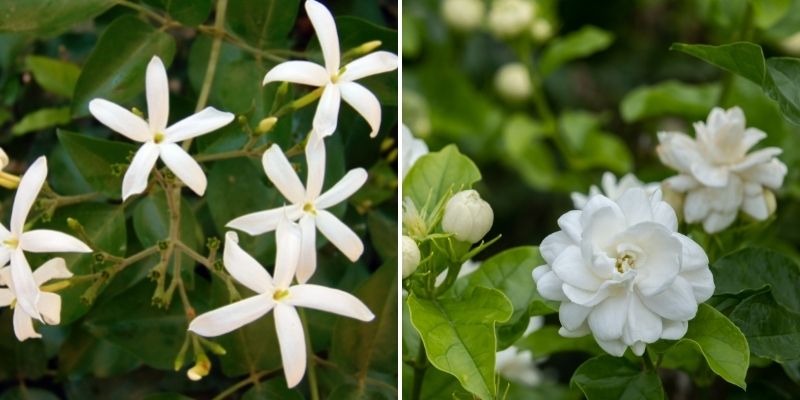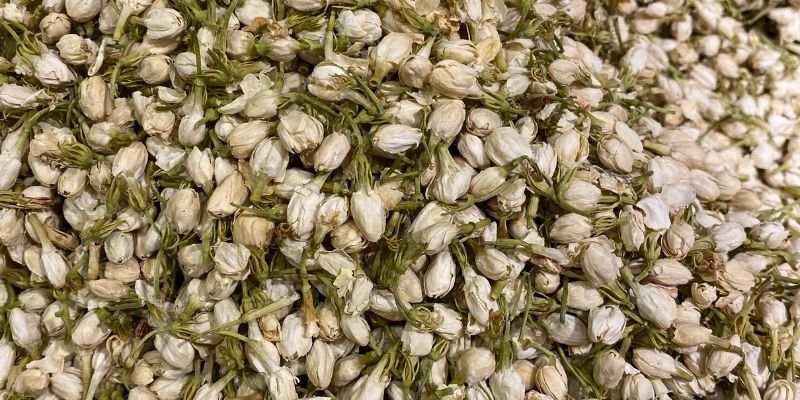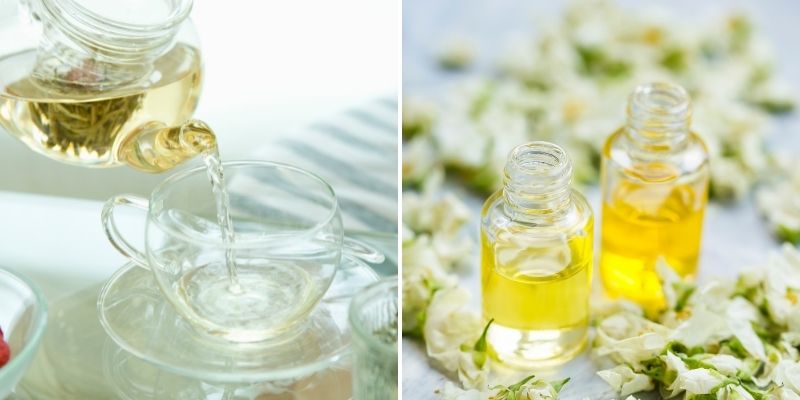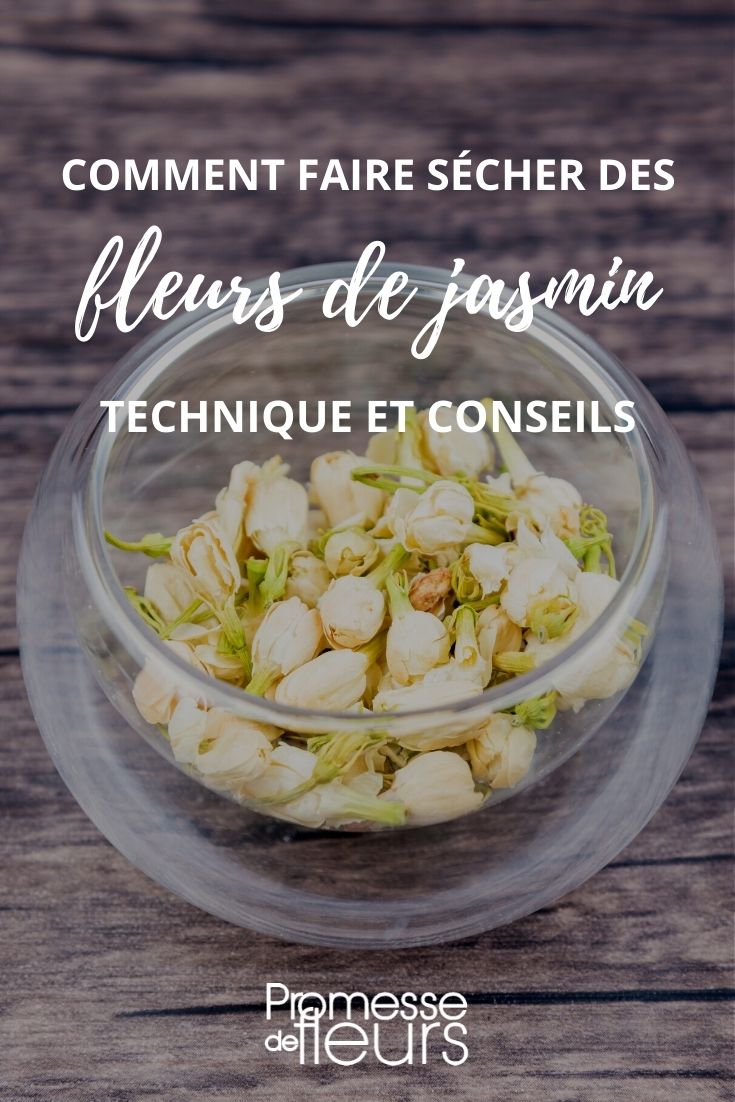Jasmine flower gives off a headed scent. It is, for this reason, widely used in perfumery, much like rose.
While it is very common around the Mediterranean, this climbing plant actually originates from Asia, more precisely the Himalayas. It thrives in warm climates, where its scent is intensified and more powerful.
Depending on the jasmine species, aside from abundant and fragrant flowering, differences exist. Foliage may be evergreen, semi-evergreen, or even deciduous in these latitudes. Growth of the liana also varies.
To use jasmine at home, the simplest solution is to dry the flowers. Here are some tips to do it well. But first a brief note on jasmines generally used.
Which jasmine to use?
In perfumery
Among jasmines most frequently used in perfumery are Jasminum grandiflorum and Jasminum officinale, from which perfumers extract the absolute using solvents. This is a very specific process, not reproducible at home. But you can enjoy jasmine’s intoxicating scent at home by drying the flowers.
Which jasmine for making tea?
For jasmine tea, a different jasmine is generally used: Arabian jasmine, Jasminum sambac, whose large white flowers are added to green tea to flavour it.

Jasminum officinale et Jasminum sambac
Is jasmine toxic? Particular case of star jasmine
The jasmines mentioned above, which belong to genus Jasminum, are part of family Oleaceae. As for star jasmine, although its flowers recall the scent of Jasminum, it does not belong to the same family. Trachelospermum belong to family Apocynaceae. Many plants in that family are toxic. As a precaution, it is therefore better not to use its flowers.
When and how to pick jasmine flowers?
When?
Picking of jasmine flowers should be done during flowering, which occurs from August to October. It is generally recommended to pick the flowers before they are fully open.
Traditionally, in town of Grasse, known as City of Perfumes, harvest of jasmine flowers begins before dawn from 5 am. Harvesting early in the morning prevents jasmine flower scent from evaporating under the effect of the sun.
Choose a dry, sunny day so humidity level is as low as possible.
How to harvest jasmine flowers?
The picking itself is fairly easy, but can be very time-consuming before you manage to obtain a modest quantity of flowers.
Simply pinch the base of the flowers so they detach.
How to dry jasmine flowers?
Jasmine flowers are delicate. For drying to take place correctly, it is important that flowers laid out to dry are not too “soft”. If you picked them already very open, they may look lacklustre after drying.
In a shady, airy place, carefully lay jasmine flowers on a cloth making sure they do not touch. After a few days, they will have dried. They should retain a light colour and all their scent after drying. Check your harvest before storing.
How to store jasmine?
Jasmine flower is fairly fragile. Keep it away from light, heat and humidity.
Storing in a paper bag placed in a dry cupboard is a good solution. If you are sure the flowers contain no trace of moisture after drying, you can then place them in an airtight box. However, if on reopening your box you notice the colour of the flowers has changed and become darker, this is not a good sign. Do not consume them.

How to use dried jasmine flowers?
In tea or as an infusion
Make your own jasmine tea by adding to your tin or sachet of green tea a few jasmine flowers, according to taste, so they flavour your drink.
You can also make an infusion from jasmine flowers by pouring boiling water over them and letting steep for about ten minutes.
Jasmine flower is said to have calming and relaxing properties. It may relieve headaches and promote sleep.
In cosmetics
It is possible to make an infusion with dried flowers for a facial treatment. Pour about 500 ml of boiling water over a handful of flowers. After about fifteen minutes, strain and wait for the infusion to cool. You can then apply it to your face either with a cotton pad or using a spray bottle.
Renowned as rich in antioxidants, this infusion may slow skin ageing. It is also considered to have a purifying effect on the skin.

Jasmine flower infusion and maceration in an oil.
To scent linen
Thanks to the heady scent of the flowers, it is possible to pleasantly scent linen by placing sachets containing dried jasmine flowers in your wardrobes, between clothes and sheets, as is often done with lavender.
In an oil macerate
You can also try making an oil macerate. This is a preparation consisting of macerating plants in a vegetable oil, generally for several weeks. It is preferable to use dry plants for this purpose to avoid oil fermentation and the development of bacteria.
Choose a neutral oil to allow jasmine’s scent to fully express itself. After a few weeks, after straining, you should obtain a delicately scented oil, ideal for massages.
Jasmine absolute
As mentioned above, the extraction of jasmine absolute is a very specific technique that seems far too complex to be reproduced at home. The operation must be carried out very quickly, within hours of harvest. Moreover, if it takes 2 h for a professional picker to collect 1 kg of flowers, and 8 kg of those are needed to obtain 1 kg of absolute, it is easy to understand why the latter is so precious.
































Comments